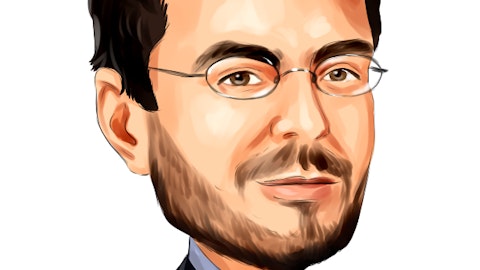Yale Jen : Just for the nine patients you recently completed, are — they have any sort of difference compared to the prior patients? Or they are very much similar to the ones you have enrolled before?
Robert Martell : Yes. Hey, Yale Jen. I would say there’s basically similar for all intents and purposes to the prior patients under Phase 1. In general, we’re enrolling patients, essentially last line patients who’ve had all available therapies. And so again, these patients are in a very difficult situation. And like we’ve said before, the fact that we’ve been seeing efficacy — such striking efficacy in the earlier patients is pretty amazing, honestly. So we’re just continuing to enroll that same population. Eventually, once we identify a recommended Phase 2 dose, we’ll be, as we’ve mentioned, selecting targeted patients who are much more likely to respond. So patients with the two splicing factor mutations, SF3B1 and U2AF1, we’ll be selecting only those patients going forward once we get to our recommended dose.
Similarly, the FLT3 mutation as well, that’s another selective patient population that we’ll be investigating in the future as soon as we get our recommended dose.
Yale Jen : Okay. Great. And maybe just to elaborate a little bit more in terms of the previous question, which is that what you — what should we see any read-through from the ASH meetings, just the data as presented not too long ago? And thanks.
Robert Martell : Well, I think the biggest read-through from my perspective was the fact that, as you remember, back in 2022, we had, had pretty striking data early in the year and towards the ASH of the year prior. One of the exciting things about ASH this last year was that we essentially doubled the patient population and continued to see — continue to see very dramatic activity, including multiple new responses. Oftentimes, you can get a signal in the first couple of patients and then it never pans out in the end. Well, in this case, it’s continuing as we expand our database. And also the fact that these patients are having really durable responses when they get a response over six months. And almost all of the patients had, had prior HMA, which is, as you know, a very difficult patient population to treat.
The median survival, as we’ve said before, in AML for these patients is about 2.5 months. So we’ve been really excited to see the data that we’ve gotten so far. And that was really the big read-through is that we continue to get it as we’re, like essentially doubling the patient population.
Operator: And our next question will come from Li Watsek of Cantor Fitzgerald.
Unidentified Analyst: This is Rosemarie on for Li. So regarding the nine patients and your discussion with the FDA, would you be able to tell us potentially what types of data you would be collecting and talking about with them. And when do you anticipate you might communicate the feedback with The Street after the 3Q meeting?
Robert Martell : Well, let me start with the data and then maybe Jim can talk about the communication. So the FDA is — so you may be familiar with Project Optimus. So let me start from there. This is an effort that the FDA has undertaken in the last year or so to try to participate much more in the determination of the recommended Phase 2 dose for essentially oncology drugs that are going through Phase 1. And so they’ve kind of set some guidelines around this, and one of which is exploring multiple doses where there is some efficacy and safety. So in the example of emavusertib, we’ve had actually three doses that met our safety criteria, meaning that we felt that they were safe. They didn’t have a high rate of dose-limiting toxicities but all three doses also had some efficacy.
We had explored the 300 and the 400 dose twice daily and felt that the 300 offered a comparable efficacy to the 400 when we evaluated that. Well, we had originally only evaluated three patients at the 200. So the FDA just wanted us to explore that a little bit more, and that’s the goal for the nine patients is to get that total up to 12 patients. So that since we did have some efficacy at that dose level, they wanted to better understand that as well. And ultimately, that’s the driving force around why they’ve asked us for this. And we don’t think this is unique to Curis or emavusertib, I think that they’re really doing this for all companies who are in their early Phase 1 development.
James Dentzer : Yes. Let me add to that, Li. So first, when we talk about the different dose levels, as Bob said, we know Project Optimus is about trying to find the lowest dose that can lead to that optimal efficacy level. I think one of the things that gets us so excited is that all of the doses at 200, 300 and 400 that we tested have efficacy. That’s the good news. It’s also the good news if you’re interested in Project Optimus because, of course, it means you want to make sure you fully explore those. The question about data that we would have by the end of the year, we’re still anticipating that we’re going to have data in both leukemia and lymphoma by the end of the year. My hope is that we’re going to have some output from FDA as well to talk about.
Whether or not we end up at 200 or 300 remains to be seen, of course. Right now, we’re just doing everything that the FDA has asked, and we are thrilled that we were able to get the sites open and patients enrolled ahead of schedule. And I think, as I said in my comments, it reflects both the dire situation that these patients are in, the critical unmet need and the excitement among our investigators to get this new therapy in and treating patients.




